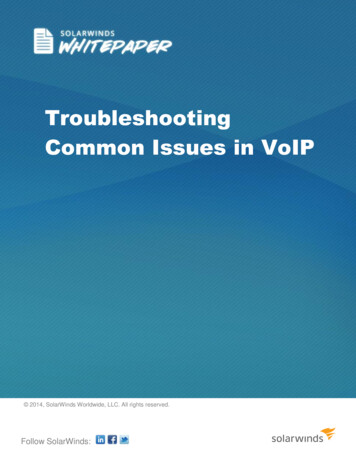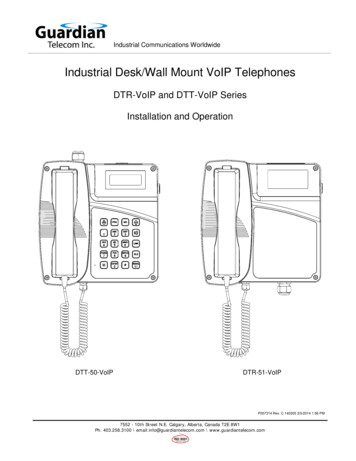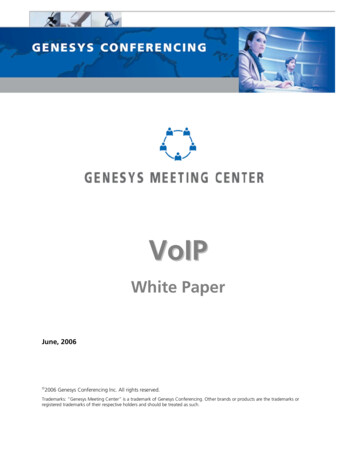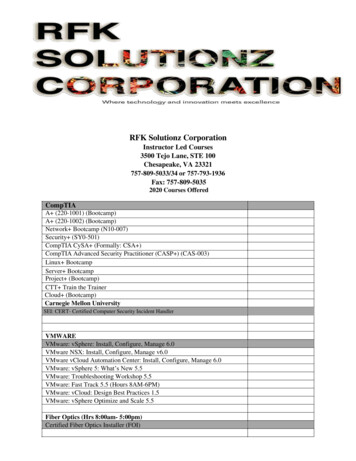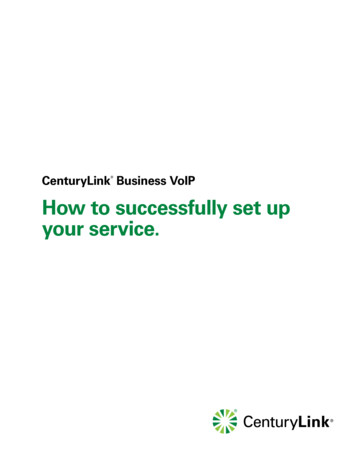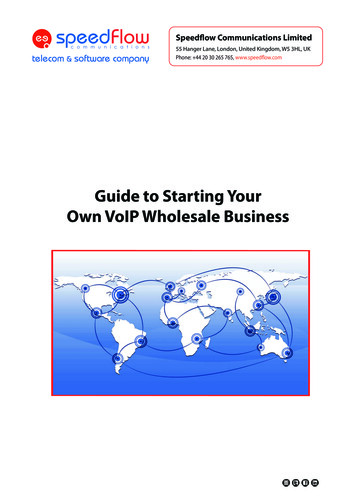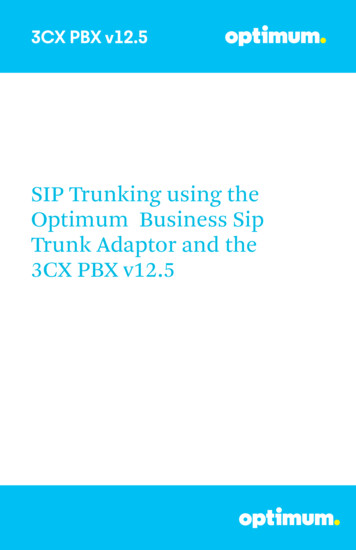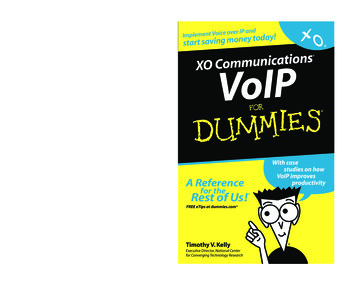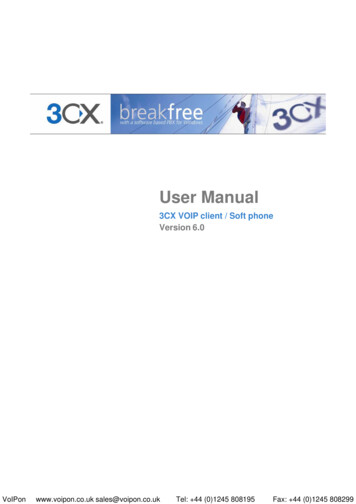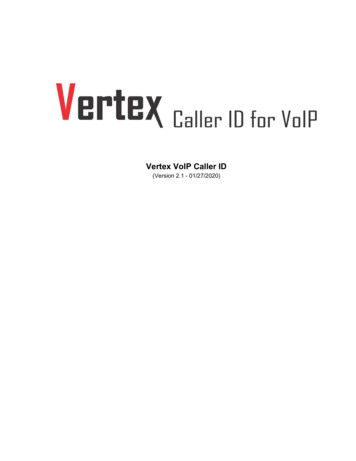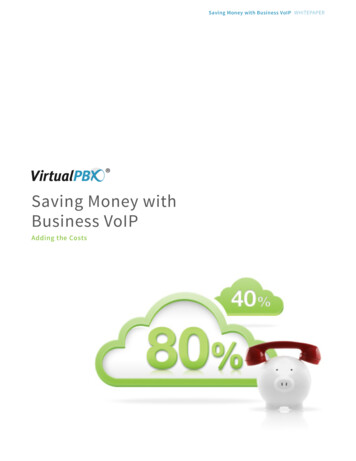
Transcription
Saving Money with Business VoIP WHITEPAPERSaving Money withBusiness VoIPAdding the Costs
Saving Money with Business VoIP WHITEPAPERTable of ContentsIntroduction01Parts of a Phone System02Dial-tone and “lines”Call routingCustom featuresPhone System Costs04Lines and Service FeesCall Routing (PBX) HardwareSupport and maintenance feesPhonesUsage FeesTaxes and Governmental FeesConclusions: The Numbers – How Much Can You Save?06Typical Monthly Costs for a Traditional Phone SystemTypical Monthly Costs for a Business VoIP SystemComparisonHow to get Business VoIP08
Saving Money with Business VoIP WHITEPAPERIntroductionBUSINESSES NEED PHONE SYSTEMS. EVEN IN TODAY’S WORLDOF WEB SITES, ONLINE CHAT, EMAIL, & INSTANT MESSAGING,THERE IS STILL NO SUBSTITUTE FOR BEING ABLE TO TALKDIRECTLY WITH YOUR CLIENTS, SUPPLIERS, AND EMPLOYEES.PHONE SYSTEMS PROVIDE FOR THIS DIRECT INTERACTION,FROM ROUTING INBOUND CALLERS TO THE RIGHT INDIVIDUALOR DEPARTMENT, TO PROVIDING DIAL TONE FOR OUTBOUNDCALLS, AND EVERYTHING IN BETWEEN. THIS HAS BEEN TRUEEVER SINCE THE FIRST COMPANIES USED MR. BELL’S INVENTION TO HANDLE BUSINESS ISSUES.The big change in our era is the addition of a new type of virtual phone system, business VoIP, which combines traditional telephony with the Internet “cloud” to providemore capabilities, greater flexibility, and significant costs savings. In our challengingenvironment, the idea that most companies can save 40% to 80% on monthly phonecosts is motivating. Getting more features and greater freedom of implementation is“icing on the cake.”This paper will examine the numbers behind these savings and provide informationabout how to get them for your company.PAGE 01
Saving Money with Business VoIP WHITEPAPERA switching device that connectsParts of a Phone Systembusiness telephones into a cohesiveThe list included here will be the minimum needed to understand the topic rathersystem and routes calls to individualthan an exhaustive study of everything that goes into a phone system. Throughoutphones or employees.this paper, we will be discussing business phone implementations rather thanPBX (Private Branch Exchange)residential service.Dial-Tone and “Lines”Phone calls are sent over transmission mechanisms like copper wires orInternet connections. Most of us understand that a single phone line cancarry a single conversation. You can take an incoming call on your line, oryou can pick up your phone and get a dial tone to make an outbound call.This one-to-one line definition is not quite the same in VoIP telephony.Most companies will have a single broadband (or better) Internet connectionthat can carry all their calls and if they implement a business VoIP phonesystem, the traditional concept of a phone line goes away. Instead, mosthosted PBX providers talk about “users” or “extensions”. In analog systems auser extension is usually the desk phone employed by a specific worker. In abusiness VoIP system, an extension typically connects to a specific person,who can take calls on a VoIP phone, a cell phone, an analog phone, or anycombination of these.PAGE 02
Saving Money with Business VoIP WHITEPAPERHardware PBXThe traditional, premise-based switch towhich office phones are connected, typically through standard phone wires. Callrouting is done by connecting individualcalls with the appropriate desk phones.Call RoutingOne of the most important functions of a phone system is the connection ofcallers to the right employee in your business. This is one of the functionsof the PBX – whether you have a premise-based hardware PBX or cloud-basedhosted PBX. Sometimes all calls go to a human receptionist, who then connects callers to the person of their choice by transferring the calls using thePBX switch, and sometimes calls go to a “virtual receptionist” or auto-attendant that plays a recorded greeting and gives callers a menu of key-pressesthat will get them to the appropriate employees.Companies who use traditional phone systems will need to purchase a hardware PBX. This can be a substantial up-front capital expense, though it canusually be amortized over the life of the system into a monthly fee. In smallersystems the PBX is often built into the cost of the phone system itself, andusers buy the function as they purchase the entire phone package.Traditional phone systems also have ongoing monthly maintenance costs,while in virtual systems, maintenance and upgrades are usually covered bythe service provider.Hosted PBXA PBX service that moves the PBX functions off-site, eliminating the capitaland maintenance expenses of a hardware switch. Call routing can be doneover traditional analog phone lines toexisting phones or over the Internetusing VoIP.Custom FeaturesSimply providing lines and connecting callers to your employees is only thebeginning of what most of us want a phone system to do. Most systems todayoffer added features like voicemail, holding queues (ACD queues), call recording, and more. In general, more features are available at a lower cost usingbusiness VoIP than with traditional PBX systems, partially because a virtualsystem shares the costs of such features across all of the system’s users, whileusers of a premise-based system have to pay for all of it themselves. For thepurposes of this paper, we will assume a mid-range feature set and try tocompare apples to apples, not oranges or kumquats.PAGE 03
Saving Money with Business VoIP WHITEPAPERVoIPVoice over Internet Protocol. The technology that sends phone calls (voice)over the Internet. This often replacestraditional telephony that sends callsover traditional analog phone lines.Phone System CostsLines and Service FeesTraditional phone systemBusiness phone lines typically cost 40 to 60 per month. If you pay the upfront costs of a hardware PBX, you may notneed a line for every phone – but you would want a minimum of one linefor every concurrent phone call. In this paper, we’ll assume 2 extensions peranalog line when a hardware PBX is included, and a middle-level 50per month per line.Business VoIP systemCost per user extension can be as low as 20 permonth, but some providers charge 40, 100, or even 200 per month.In this paper, we’ll use 25 per user per month, which leans toward a lowercost provider.Call Routing (PBX) HardwareTraditional phone systemPBX switches are fairly expensive. Acceptedfigures for the capital expense for such systems range from 500 per userto 2,000 per user. This is a one-time cost, and includes the costs of thewiring. To be fair, this paper will use a figure toward the lower end of thisrange at 1,000 per user. So a 10-user PBX, installed and wired would costabout 10,000.PAGE 04
Saving Money with Business VoIP WHITEPAPERTraditional Phone SystemThe combination of analog phones,lines, and hardware PBX that has beenin use for many years.This capital expense can usually be amortized over the useful life of the system, turning the up-front cost into a monthly expense. We’ll include thiscost as a monthly expense in this paper, but we’ll identify it so you can backit out if you already own your PBX system. Amortization will be over 4 years,with no interest.Business VoIP systemSince the business VoIP service provider owns andoperates the PBX hardware, there is no expense, capital or monthly, for users.Support and Maintenance FeesTraditional phone systemPBX hardware must be maintained andupgraded from time to time. The cost of this maintenance may be paid as ithappens, or it may be part of a monthly service fee from the company thatprovides the maintenance. In this document, we’ll include a monthly costequaling 1% of the initial system cost. Again, we’ll identify this cost specifically in case you want to back it out from your calculations.Business VoIP systemThis cost is borne by the service provider.PhonesVirtual Phone SystemA PBX service that moves the PBX functions off-site, eliminating the capitaland maintenance expenses of a hardware switch. Call routing can be doneover traditional analog phone lines toexisting phones or over the Internetusing VoIP.Costs for business phones are similar between analog systems, so we’ll leavethem out of the comparisons. A good phone can run from well under 100 to 1,000 or more.Usage FeesBoth traditional and VoIP systems have costs for inbound calls to a toll freenumber and for dialing out to international destinations. Business VoIPsystems are usually less expensive in both these areas. However, many businesses don’t have toll free numbers or dial out to international numbers,so these costs will be left out of our comparisons. If your company has needsfor either of these capabilities, you’ll probably save a little more withbusiness VoIP.Traditional phone systemThe main “usage” fee for traditional systemscomes from making long distance phone calls. Rates vary widely. Lower ratesusually come with higher monthly costs for lines. In this document, we’llassume a cost of 6 cents per long-distance minute, and further estimate that80% of outbound calls will be long-distance.Business VoIP systemMost business VoIP providers include free longdistance within their own country. US clients can often find providersthat will include free long distance for calls anywhere in the continental USand Canada.PAGE 05
Saving Money with Business VoIP WHITEPAPERBusiness VoIP SystemA hosted PBX that is connected mainlyvia VoIP technology. While calls cango to standard phones and mobiledevices, costs are reduced by using VoIPconnections instead of traditionalanalog phone lines.VoIP providers often talk about “unlimited” minutes, which covers bothinbound and outbound (both local and long distance) calls at no charge. Onecaution, however, is that the term unlimited applies only to “typical businesstraffic.” There really is a cap on the number of minutes allowed, but it’s highenough that most clients won’t hit it. You should always check the “fair usepolicy” of any VoIP provider and make sure your usage will fall within theirdefinition of typical business traffic. If the company you’re working with isn’tupfront about their fair use policy, be especially careful.Taxes and Governmental FeesBureaucracy is alive and well in our markets. Death and taxes are our constants, and taxes happen a lot more often. From federal universal service feesto e911 recovery fees, you’ll always see governmental overrides. These costsare similar for both types of systems – a little higher in traditional systemsfor telecommunications fees and a little higher in VoIP business systems forspecial things like e911 service – and so will be left out of this analysis.Conclusions: The Numbers – HowMuch Can You Save?Phone system costs scale up as you add users and traffic. In this analysis, we assume a company size of 20 employees, and the average number of minutes per useris 1,000 combined inbound and outbound minutes. For a 10-user company dividethe monthly costs by 2; for a 100-user company multiply the monthly costs by 5.PAGE 06
Saving Money with Business VoIP WHITEPAPERTypical Monthly Costs of aTraditional Phone SystemNumber of Users20LandlinesCost of land lineUsers per land lineNumber of land lines neededMonthly cost of landlines 50.00210 500.00Long DistanceAverage minutes per user1,000Total minutes per month20,000Long distance rate 0.06Outbound % of total minutes50%Outbound long-distance80%Long distance minutes8,000Monthly cost of long distance 480.00Total monthly costs - excluding PBX 980.00Traditional PBXOriginal cost of PBX 20,000.00Monthly cost of PBX - over 4 years 416.67Monthly PBX maintenance/support 200.00Monthly PBX cost incl. maintenanceTotal Monthly Cost - Including PBX 616.67 1,596.67Typical Monthly Costs for aBusiness VoIP SystemNumber of UsersCost per user per month20 25.00Total monthly cost of service 500.00Monthly cost of long distance0Average minutes per userMonthly PBX cost incl. maintenanceTotal Monthly Cost - Hosted PBX1,0000 500.00PAGE 07
Saving Money with Business VoIP WHITEPAPERComparisonAs can be seen by the numbers above, the savings potential is very high bymoving away from traditional telephony and to business VoIP. Based on thisanalysis, the specific savings are found in the following table:Monthly VoIP Savings without hardware PBX Costs 480.00Savings Percent49%Monthly ViOP Savings including hardware PBX Costs 1,096.67Savings percent69%How to get Business VoIPAs the inventors of the first hosted PBX, we at Virtual PBX hope you’ll come to us.We started the virtual phone system revolution in 1996 and have the deepest featureset in the industry. For more details about our company and our services, pleasevisit our website at www.virtualpbx.com, or call us at 888-825-0800.We’ll help you get started, or just answer questions. The sooner you call, the soonerthe savings can start.1 (888) 825-0800 U.S.info@virtualpbx.com1 (408) 414-7646 Internationalvirtualpbx.com 1998–2013. VirtualPBX.com, Inc. All rights reserved. Virtual PBX is a trademark of VirtualPBX.com, Inc
Traditional phone system Business phone lines typically cost 40 to 60 per month. If you pay the upfront costs of a hardware PBX, you may not . Business VoIP system Cost per user extension can be as low as 20 per month, but some providers charge 40, 100, or even 200 per month.
